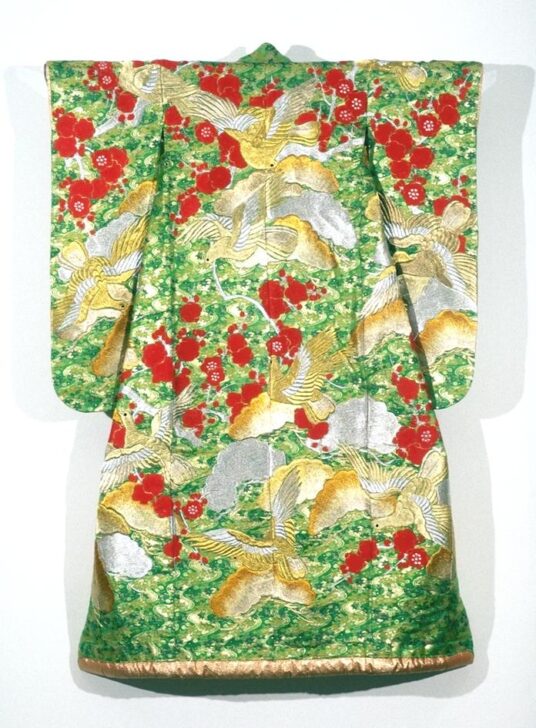Wedding cloak
Japanese

Description
Wedding cloak (uchikake)
Japan, Showa period (1926–1989)
1920–80
Silk brocade with gilt paper (kinran), embroidery, and couched metallic threads
Gift of Diana and Theodore Golden, 1986/1.215
Traditional attire has virtually disappeared from the city and countryside in modern Japan as a type of dress for work or play, but it retains a significant place in ceremonial contexts. Young women in particular often choose expensive kimono for coming-of-age ceremonies or college graduation parties—one an ancient aristocratic tradition only recently adopted by the middle class, and the other new to the twentieth century. Wedding costumes are the most extravagant of all, as seen in this spectacular uchikake. No expense has been spared in this cloak’s materials or workmanship. The apple-green fabric is pure silk brocade, woven in an overall pattern of maple leaves scattered on a flowing stream—an allusion to a famous classical poem. On top of the brocade is a thick layer of embroidery, with plum blossoms in red silk, and pine branches and doves in dazzling metallic threads of gold, silver, and copper. The combination of motifs is unusual, and may have been explicitly commissioned by the wearer. Wedding cloaks such as this have long, padded hems that are red or orange in color and drag on the floor as the bride walks; they are worn over a wedding kimono and obi (sash). Due to its thickness and weight, the uchikake is never belted closed.
Subject Matter:
Traditional attire has virtually disappeared from city and countryside in Japan, whether for work or play, yet it retains a significant place in Japanese life in ceremonial contexts. Wedding costumes are the most extravagant of all kimono, as seen in this spectacular uchikake or cloak.
Physical Description:
The apple-green fabric is pure silk brocade, woven in an overall pattern of maple leaves scattered on a flowing stream—an allusion to a famous classical poem. Lying on top of the brocade is a thick layer of embroidery, with plum blossoms in red silk, and pine branches and doves in dazzling metallic threads of gold, silver, and copper.
Usage Rights:
If you are interested in using an image for a publication, please visit https://umma.umich.edu/request-image/ for more information and to fill out the online Image Rights and Reproductions Request Form.